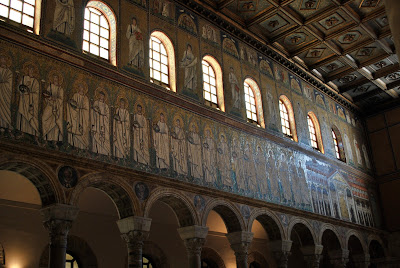yesterday i conquered my fears of traveling alone and took myself on a trip to padua (or padova in italiano). padua is about an hour and a half northeast of florence, near venice. as the train was nearing the station, i glanced at the map in my guidebook for the first time and i realized that neither the train station nor the two sites i wanted to visit were within the range of the map. oh dear. i'll admit i panicked a little. why did i think i could just show up in foreign city by myself and figure things out? but fortunately, i did. it was a beautiful sunny day and there were well-placed signs pointing the way to the major sites so my worries were quickly relieved. first i went to the church of sant'antonio, dedicated to st. anthony of padua. st. anthony (1195-1231) was born in portugal but traveled extensively in france and italy as a franciscan preacher before retiring to padua. he was named a doctor of the church and is the patron of lost things.
there was ugly scaffolding covering the facade but the domes are quite lovely. you're not allowed to take pictures inside but the interior is beautiful. it's mostly gothic with frescos covering the ceiling and there are also some baroque additions, particularly the chapel of relics behind the alter which is just an explosion of baroque gaudiness. also of note is st. anthony's tomb which is surrounded by offerings of photos with prayers written on them.
also in the piazza outside is this statue by donatello which, when it was finished in 1450, was the first equestrian monument since antiquity.
the other site i was dying to see in padova was the scrovegni chapel and its famous frescos by giotto. this chapel, commonly known as the arena chapel, was commissioned by enrico scrovegni after he read dante's divine comedy which puts scrovegni's father in the seventh circle of hell for the sin of usury--changing interest for lending money--which was apparently frowned upon at the time. enrico decided to invest some of his family fortune acquired by this grave sin in a magnificent chapel, hoping to save his father (and presumably himself) from the fate described by dante. the fresco series on the two side walls depict scenes from the life of the Virgin and the life of Christ. the front wall is covered by a representation of the last judgment. the chapel was completed around 1305 and caused a revolution in the art world.
it's always super exciting to see the pieces i've studied in real life and this was no exception. reproductions just never manage to capture the visual splendor of the original. it was overwhelming. my favorite things about giotto are his angels and his the gestures of his figures. especially in the lamentation of christ. the way st. john's hands are thrown back behind him and the anguished poses of the angels in sky make for a very moving scene.
there was also a pinoteca in the museum next to the chapel that had works by titian, tintoretto, and veronese, among others. it never ceases to amaze me how many great works of art you can find, even in the smaller italian towns.
on the train ride back at the end of the day, i felt a surge of accomplishment. i had a really great time seeing things i wanted to see. i like nothing more than to spend hours in churches and museums but i realize that's not necessarily for everyone. it was nice to just enjoy the art and not have to worry about whether the people i was with were having fun. i was glad that i wasn't too scared to take the adventure alone - i felt like such a grown-up!






















